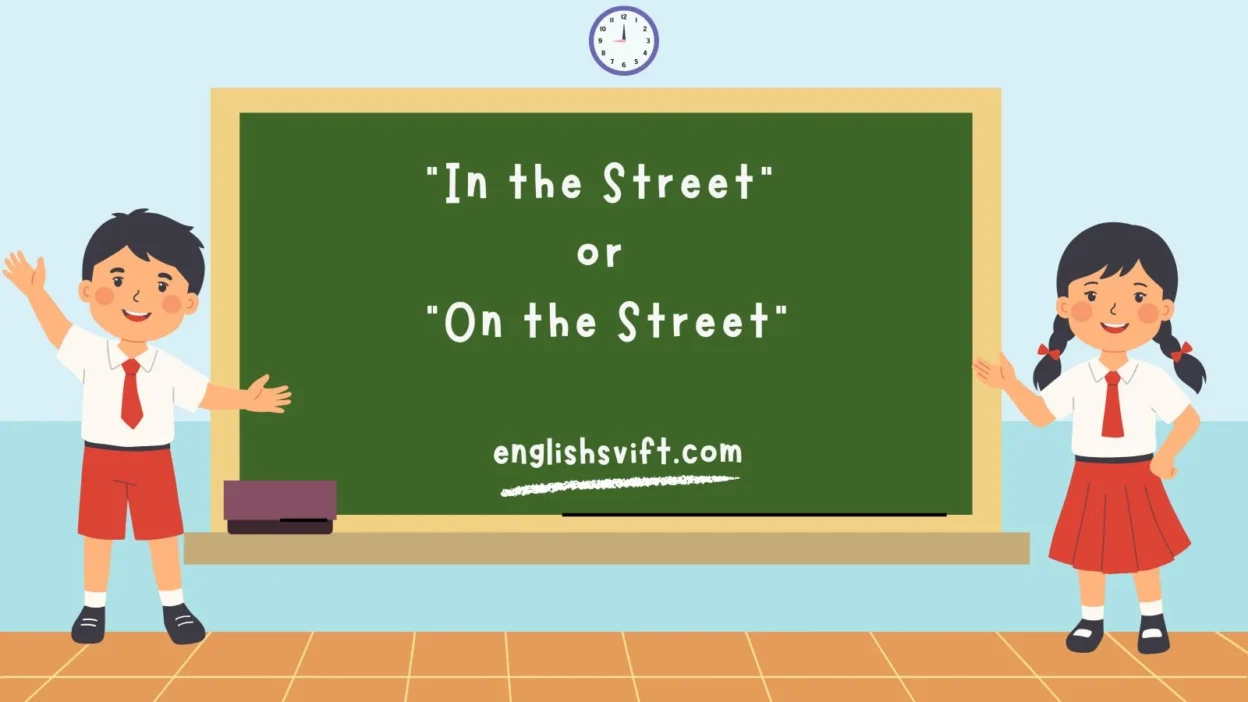When learning English prepositions, even simple phrases can become tricky and confusing. Two expressions that often puzzle both ESL learners and native speakers are “in the street” and “on the street.” At first glance, they may appear interchangeable, but subtle nuances, contexts, and connotations make them quite different.
If you’ve ever wondered why someone says “children are playing in the street” while another says “I met my friend on the street,” this guide will clear up the confusion. We’ll explore grammar rules, real-life examples, regional preferences, cultural differences, and situational accuracy.
By the end, you’ll have a clear understanding of when to use each phrase, how they shape your message, and how to sound natural and precise in both writing and conversation. So, let’s dive into the street vs. on the street debate and bring clarity to your English journey.
The Core Difference Between “In the Street” and “On the Street”
At its heart, the difference comes down to location and perspective.
- “In the street” means someone or something is physically within the roadway itself — the part where cars drive, buses move, and potential danger exists.
- “On the street” refers to the general area of the street, including sidewalks, adjacent spaces, and activities happening around or along it.
👉 Think of it like this:
- If you’re in the street, you’re standing in the middle of traffic.
- If you’re on the street, you’re located along the street, perhaps walking on the sidewalk, near shops, or just referencing it generally.
| Phrase | Core Meaning | Example | Risk/Safety | Usage Context |
| In the street | Physically inside the roadway, between vehicles | “The kids were playing in the street.” | High risk – cars, accidents, hazards | Action happening within traffic space |
| On the street | General reference to the area of the street, including sidewalks | “I met my friend on the street.” | Safe – adjacent areas, sidewalks, shops | General communication, social encounters |
Understanding Prepositions in Everyday English Usage
English prepositions like in, on, at, under, over can change meaning drastically depending on context. With streets:
- “In” emphasizes being inside or enclosed within boundaries.
- “On” emphasizes being alongside, above, or part of a surface.
🔑 Quick Pro Tip:
- Think of “in” = engulfed, surrounded.
- Think of “on” = placed, adjacent, connected.
Visualizing Space: Surrounded vs. Adjacent Contexts
One way to picture the difference is through spatial imagination:
- If you’re in the street, the environment engulfs you — cars, movement, and traffic around.
- If you’re on the street, you’re next to it, walking along, or referencing its surroundings.
| Preposition | Imagery | Visual Cue | Example Sentence |
| In | Enclosed, surrounded, immersed | Standing in the middle of traffic lanes | “He stood in the street waving at cars.” |
| On | Surface, adjacency, general placement | Walking along a sidewalk, next to shops | “She’s on the street near the bookstore.” |
In the Street: Meanings, Actions, and Real-Life Examples
When we say “in the street”, it often refers to:
- Children playing with a ball in the middle of the road.
- Protesters marching and blocking traffic.
- Musicians performing in traffic lanes.
- Cars stalled or accidents lying across the road.
📌 Examples:
- “The ball bounced, and the child ran in the street after it.”
- “Protesters were sitting in the street, blocking vehicles.”
- “A musician stood in the street performing for passersby.”
⚠️ Notice the dangerous or obstructive nature of being in the street.
On the Street: Meanings, Uses, and Natural Expressions
The phrase “on the street” has broader, safer, and sometimes metaphorical uses.
It can mean:
- Walking along sidewalks.
- Meeting someone casually.
- Referring to the street as a public space.
- Describing people without homes (“living on the street”).
- Speaking metaphorically (“word on the street is…”).
📌 Examples:
- “I met my old friend on the street yesterday.”
- “Many vendors sell food on the street near Times Square.”
- “Sadly, some people are forced to live on the street.”
- “Word on the street is that the café is closing.”
American vs. British English Conventions: Subtle Variations
In British English, “in the street” is more common when describing location, while in American English, “on the street” dominates.
| English Type | Preferred Usage | Example |
| British English | “In the street” | “The children were playing in the street outside their house.” |
| American English | “On the street” | “I saw a musician on the street downtown.” |
🔎 Google Ngram Viewer shows that “on the street” has been more popular globally, especially in American writing.
Grammar Guidelines: Accuracy and Precision in Usage
To avoid confusion, follow these grammar tips:
- Use in the street when describing actions physically happening in the roadway.
- Use on the street when describing general presence, location, or broader reference.
- Avoid using them interchangeably unless context clearly supports both.
📌 Wrong Usage Example:
❌ “I met my teacher in the street” (implies you both stood in traffic).
✅ Corrected:
✔ “I met my teacher on the street” (casual, safe, natural).
Everyday Communication: How People Use These Phrases in Life
- Parents warn: “Don’t play in the street!”
- Friends say: “Let’s meet on the street corner.”
- News reports: “Protesters gathered in the street.”
- Gossip spreads: “The word on the street is that a new store is opening.”
👉 Notice how context changes meaning instantly.
Examples of Children, Friends, and Pedestrians in Context
The phrases really shine when tied to real-life situations.
| Scenario | Correct Phrase | Why It Works | Example Sentence |
| Kids chasing a ball | In the street | Kids are physically inside the roadway | “The children were playing in the street until their mother called them in.” |
| Meeting someone casually | On the street | A general location, not inside traffic | “I bumped into an old school friend on the street yesterday.” |
| Pedestrian walking safely | On the street | Refers to sidewalks and walking areas | “There were many people on the street during the parade.” |
| Danger warning | In the street | Indicates risk, danger, or hazard | “Don’t stand in the street, it’s dangerous!” |
👉 Rule of Thumb: If there’s danger from cars, use in. If it’s about location, meeting, or walking, use on.
Streets, Roadways, and Sidewalks: Boundaries and Surroundings
To master these prepositions, you must understand the layout of a street.
- Roadway: The part where vehicles move.
- Sidewalk/Pavement: The safe walking area for pedestrians.
- Adjacent Spaces: Shops, cafés, and homes next to the street.
| Street Element | Related Phrase | Example |
| Roadway | In the street | “A car broke down in the street.” |
| Sidewalk | On the street | “Vendors sell snacks on the street corner.” |
| Shops/Cafés | On the street | “There’s a bookstore on the street near my apartment.” |
This distinction between road surface and adjacent space is the root of the difference.
Activities and Engagement: Playing, Walking, Protesting, Performing
Many activities can happen both “in” and “on” the street. The preposition choice depends on perspective.
| Activity | Correct Preposition | Example |
| Protesting | In the street | “Protesters gathered in the street, blocking traffic.” |
| Walking | On the street | “I enjoy walking on the street near the park.” |
| Playing | In the street | “The kids played football in the street.” |
| Performing Music | On the street | “Buskers perform songs on the street in big cities.” |
| Selling Goods | On the street | “Vendors sell flowers on the street corner.” |
👉 Notice that “on” is linked to commerce, culture, and safe activities, while “in” relates to traffic space and risk.
Safety and Hazards: The Risk of Being In the Street
Standing in the street often carries negative or hazardous connotations.
- Traffic Accidents: “A dog ran in the street and caused a car to stop suddenly.”
- Police Warnings: “Move away, you can’t stand in the street.”
- Parenting Advice: “Kids, stay out of the street!”
⚠️ Hazard words connected with ‘in the street’: danger, accidents, injury, risk, traffic, congestion.
| Phrase | Associated Risks | Example |
| In the street | Car accidents, injury, obstruction | “The cyclist fell in the street during heavy traffic.” |
| On the street | Safer, general reference | “Food trucks lined up on the street.” |
Social Life and Culture: On the Street as Metaphor
The phrase “on the street” goes beyond location. It’s used metaphorically in culture, music, and conversation.
- Idiomatic Expression: “Word on the street” = gossip, news, or rumors.
- Homelessness: “Living on the street” = having no home or residence.
- Pop Culture: The Motown hit “Dancing in the Street” (Martha and the Vandellas).
- Street Life: “Street style” and “street food” describe lifestyle and culture.
📌 Examples:
- “Word on the street is that Nauman’s new book drops in May 2025.”
- “He’s been on the street since losing his job.”
- “Street musicians perform jazz on the street in San Francisco.”
Sentence Structures: Correct Placement of Prepositions
Prepositions must sit immediately before nouns (street). The verbs around them shape meaning.
- I stood in the street (verb = stood, dangerous placement).
- I met her on the street (verb = met, casual encounter).
📌 Wrong vs. Right:
❌ “She’s walking in the street to meet me.” (implies walking dangerously in traffic)
✔ “She’s walking on the street to meet me.” (means along sidewalks).
Common Misunderstandings and How to Avoid Them
Many learners mix them up because:
- They treat in and on as interchangeable.
- They don’t visualize the spatial difference.
- They translate directly from another language.
✅ Fix it by remembering:
- In = inside road, risky, surrounded.
- On = along road, safe, broader.
Interchangeability: Are These Phrases Ever Substitutable?
In some informal contexts, they can overlap.
Example:
- “He’s out there in/on the street protesting.”
(Both can work: “in” stresses being physically in the road, “on” is general reference).
But ❌ they’re not always interchangeable. Using the wrong one can cause ambiguity or even misunderstanding.
Clarity in Writing: Tips for ESL Learners and Students
If you’re an ESL learner or a student trying to master these phrases:
- Use in the street only when you mean inside the roadway.
- Use on the street for everything else.
- Read newspapers, novels, and blogs to see natural examples.
- Practice writing 5 sentences with each phrase.
📌 Quick Example Exercise:
- Write a sentence with “in the street” about danger.
- Write a sentence with “on the street” about meeting someone.
Comparing Meanings with Real-World Situations (Table)
| Context | “In the Street” | “On the Street” |
| Danger | Standing inside traffic lanes | Not used for danger |
| Social | Rare, unnatural | “I saw her on the street yesterday.” |
| Commerce | Not used | “Shops on the street sell clothes.” |
| Protest | “Protesters gathered in the street.” | “Protesters were visible on the street.” |
| Homelessness | Not used | “He was forced to live on the street.” |
| Music/Performance | “Dancers stood in the street blocking cars.” | “Buskers play guitar on the street corner.” |
Idioms, Expressions, and Pop Culture References
- “Word on the street” – gossip, rumors, trending news.
- “Dancing in the Street” – famous Motown classic.
- “On the streets” – life outside, often referencing homelessness or street culture.
- “In the streets” – often used in political activism (“Thousands in the streets demanding reform”).
Contextual Nuances in News, Headlines, and Media
Media outlets carefully choose these phrases:
- BBC headline: “Thousands gather in the streets of London.”
- NY Times: “Musicians perform on the streets of New York.”
- Guardian: “Protesters lying in the street halt traffic.”
👉 Journalists pick based on whether people are blocking traffic or visible along the sidewalks.
The Role of Location, Position, and Surroundings in Choice
Your position defines the preposition:
- Physically surrounded = in.
- Located near or adjacent = on.
- General referencing = on.
📌 Example:
- “The bus broke down in the street.”
- “A food truck was parked on the street.”
Grammatical Influence of Verbs on Preposition Selection
Some verbs naturally collocate with one phrase more than the other.
| Verb | Natural Collocation | Example |
| Play | In the street | “Kids play in the street.” |
| Meet | On the street | “I met him on the street.” |
| Protest | In/On (depends on emphasis) | “People are protesting in the street.” |
| Live | On the street | “Sadly, he lives on the street.” |
| Perform | On the street | “Musicians perform on the street.” |
Quick Comparison Table: When to Use In vs. On
| Use Case | Correct Phrase | Example Sentence |
| Risk, traffic | In the street | “Cars swerved to avoid someone standing in the street.” |
| Meeting casually | On the street | “I met her on the street after work.” |
| Vendors, shops | On the street | “They sell flowers on the street corner.” |
| Political protest | In the street | “Protesters gathered in the street.” |
| Homelessness | On the street | “He ended up living on the street.” |
Visual Diagram: Spatial Understanding of Each Phrase
[Sidewalk] —— (On the street) —— [Roadway] —— (In the street) —— [Traffic]
This simple diagram shows:
- On the street = safe edge, sidewalks, corners, shops.
- In the street = roadway, traffic lanes, hazard zones.
Final Thoughts: Mastering Nuances for Fluent Communication
Both phrases are correct, but precision matters.
- Use in the street for danger, obstruction, or roadway activity.
- Use on the street for general location, culture, and safe references.
Mastering this difference will make your English speech, writing, and grammar more accurate — and keep your sentences from sounding confusing or ambiguous.
FAQs
Q1: Is “in the street” wrong?
No, it’s correct but only when referring to something physically inside the roadway.
Q2: Can I use “on the street” for protests?
Yes, but it sounds less direct. Journalists often prefer “in the street” to show obstruction.
Q3: Why do Americans say “on the street” more often?
It’s a regional preference. British speakers still use “in the street” more commonly.
Q4: Can I say “I live in the street”?
No. The correct phrase is “I live on the street” (meaning homeless).
Q5: Which phrase should ESL learners focus on?
“On the street” is safer and more general. Use “in the street” carefully, only for traffic-related contexts.



